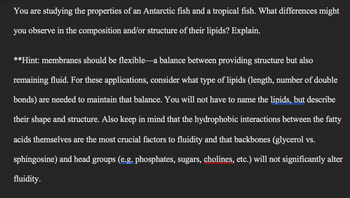
Biochemistry
9th Edition
ISBN: 9781319114671
Author: Lubert Stryer, Jeremy M. Berg, John L. Tymoczko, Gregory J. Gatto Jr.
Publisher: W. H. Freeman
expand_more
expand_more
format_list_bulleted
Question

Transcribed Image Text:You are studying the properties of an Antarctic fish and a tropical fish. What differences might
you observe in the composition and/or structure of their lipids? Explain.
**Hint: membranes should be flexible a balance between providing structure but also
remaining fluid. For these applications, consider what type of lipids (length, number of double
bonds) are needed to maintain that balance. You will not have to name the lipids, but describe
their shape and structure. Also keep in mind that the hydrophobic interactions between the fatty
acids themselves are the most crucial factors to fluidity and that backbones (glycerol vs.
sphingosine) and head groups (e.g. phosphates, sugars, cholines, etc.) will not significantly alter
fluidity.
Expert Solution
This question has been solved!
Explore an expertly crafted, step-by-step solution for a thorough understanding of key concepts.
This is a popular solution
Trending nowThis is a popular solution!
Step by stepSolved in 2 steps

Knowledge Booster
Similar questions
- Protein Structure and Folding:a. Explain how changes in a protein’s amino acid sequence can change the way it behaves in water.b. Explain how changes in a protein’s amino acid sequence can change the way it interacts with othermolecules.c. Explain how changes in a protein’s amino acid sequence can change the way it forms secondary andtertiary structures when placed in water.arrow_forwardLipid molecules do not dissolve in water because all lipids are _______. Instead, lipid molecules attract other lipid molecules, forming tight clumps. When lipid molecules are stuck to a surface (such as hands or clothing), the lipid molecules stick to each other and the surface, and water will not wash them away. Fill in the blank: A. hydrophobic B. polypeptides C. acidicarrow_forwardFats are constructed from two types of smaller molecules: a glycerol and three (????). Phospholipids Peptides Fatty acids Wisemen Two fatty acids and a phosphate group attached to a glycerol make a (????). Plasma membrane Carbohydrate Phospholipid Promethiosome The primary structure of a protein is the sequence of (????). Amino acids Fatty acids Nucleic acids Monosaccharidesarrow_forward
- Lipoprotein particles are relatively large, sphericalclumps of protein and lipid molecules (see Figure 3.18)that circulate in the blood of mammals. They are likesuitcases that move cholesterol, fatty acid remnants, triglycerides, and phospholipids from one place to anotherin the body. Given what you know about the solubilityof lipids in water, which types of lipids would you predict to be on the outside of a lipoprotein clump, bathedin the water-based fluid portion of blood?arrow_forwardThe following are functions of lipids EXCEPT A. Isolate cellular components from its environment B. Serve as signal molecules and mediators of cellular processes C. Membrane fluidity determinant D. Alternative energy source of cells O E. Facilitate movement of metabolites in and out of cellsarrow_forwardH "H H H HO Choose all of the following are true of the given structure? (Choose all of the correct answers)arrow_forward
- Glucose polymers: Which of the following is/are FALSE? a. Beta-glycosidic bonds are found in starch, glycogen and chitin b. Beta-glycosidic bonds are found in cellulose and chitin C. alpha-glycosidic bonds are found in starch and glycogen d. alpha-glycosidic bonds are found in chitin and cellulose O b,c.d O a, b, c, d а, d a,b, darrow_forwardDuring hydrogenation, cis double bonds are converted to trans double bonds. In the lab, we compare three fats, each of which has fatty acid chains that are exactly the same length (number of carbons) and observe the following: Fat 1 contains only saturated fatty acids 16 carbons long, and has a melting point of 65 degrees C. Fat 2 contains only cis unsaturated fatty acids 16 carbons long, and has a melting point of 35 degrees C. Fat 3 contains only trans fatty acids 16 carbons long, and has a melting point of 65 degrees C. Both Fat 2 and Fat 3 contain fatty acids with a single double bond; fat 1 has no double bonds. Why do Fat 3 and Fat 1 have more similar melting points than Fat 3 and Fat 2? Group of answer choices The number of hydrogen atoms in the fatty acids of fats 1 & 3 is higher, and having more hydrogen atoms raises the melting point of the fat. The fatty acids in fats 1 & 3 have a linear shape, so they pack tightly together and have lots of hydrophobic…arrow_forward
arrow_back_ios
arrow_forward_ios
Recommended textbooks for you
 BiochemistryBiochemistryISBN:9781319114671Author:Lubert Stryer, Jeremy M. Berg, John L. Tymoczko, Gregory J. Gatto Jr.Publisher:W. H. Freeman
BiochemistryBiochemistryISBN:9781319114671Author:Lubert Stryer, Jeremy M. Berg, John L. Tymoczko, Gregory J. Gatto Jr.Publisher:W. H. Freeman Lehninger Principles of BiochemistryBiochemistryISBN:9781464126116Author:David L. Nelson, Michael M. CoxPublisher:W. H. Freeman
Lehninger Principles of BiochemistryBiochemistryISBN:9781464126116Author:David L. Nelson, Michael M. CoxPublisher:W. H. Freeman Fundamentals of Biochemistry: Life at the Molecul...BiochemistryISBN:9781118918401Author:Donald Voet, Judith G. Voet, Charlotte W. PrattPublisher:WILEY
Fundamentals of Biochemistry: Life at the Molecul...BiochemistryISBN:9781118918401Author:Donald Voet, Judith G. Voet, Charlotte W. PrattPublisher:WILEY BiochemistryBiochemistryISBN:9781305961135Author:Mary K. Campbell, Shawn O. Farrell, Owen M. McDougalPublisher:Cengage Learning
BiochemistryBiochemistryISBN:9781305961135Author:Mary K. Campbell, Shawn O. Farrell, Owen M. McDougalPublisher:Cengage Learning BiochemistryBiochemistryISBN:9781305577206Author:Reginald H. Garrett, Charles M. GrishamPublisher:Cengage Learning
BiochemistryBiochemistryISBN:9781305577206Author:Reginald H. Garrett, Charles M. GrishamPublisher:Cengage Learning Fundamentals of General, Organic, and Biological ...BiochemistryISBN:9780134015187Author:John E. McMurry, David S. Ballantine, Carl A. Hoeger, Virginia E. PetersonPublisher:PEARSON
Fundamentals of General, Organic, and Biological ...BiochemistryISBN:9780134015187Author:John E. McMurry, David S. Ballantine, Carl A. Hoeger, Virginia E. PetersonPublisher:PEARSON

Biochemistry
Biochemistry
ISBN:9781319114671
Author:Lubert Stryer, Jeremy M. Berg, John L. Tymoczko, Gregory J. Gatto Jr.
Publisher:W. H. Freeman

Lehninger Principles of Biochemistry
Biochemistry
ISBN:9781464126116
Author:David L. Nelson, Michael M. Cox
Publisher:W. H. Freeman

Fundamentals of Biochemistry: Life at the Molecul...
Biochemistry
ISBN:9781118918401
Author:Donald Voet, Judith G. Voet, Charlotte W. Pratt
Publisher:WILEY

Biochemistry
Biochemistry
ISBN:9781305961135
Author:Mary K. Campbell, Shawn O. Farrell, Owen M. McDougal
Publisher:Cengage Learning

Biochemistry
Biochemistry
ISBN:9781305577206
Author:Reginald H. Garrett, Charles M. Grisham
Publisher:Cengage Learning

Fundamentals of General, Organic, and Biological ...
Biochemistry
ISBN:9780134015187
Author:John E. McMurry, David S. Ballantine, Carl A. Hoeger, Virginia E. Peterson
Publisher:PEARSON